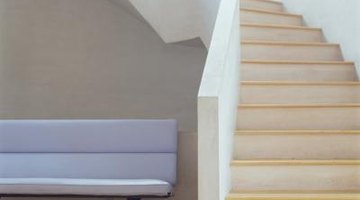DIY Double Winder Stairs
Unlike spiral or curved staircases, which have treads that twine around a pole or follow an arc as they rise, winders are stairs that turn corners. They typically connect two or more straight sections of stairs. Builders often replace the landings of L-shaped or U-shaped staircases with winder treads when space is limited, because winders take up less room than landings. An L-shaped staircase uses one section of winders to turn a single corner, while a U-shaped staircase — sometimes known as a double winder staircase — requires a set of winders. As with other types of stairs, double winder staircases can be built in a variety of design configurations.

Step 1
Familiarize yourself with your local building codes. The typical single winder is made up of three treads that turn a 90-degree corner, but winders can also be composed of two treads that turn an acute angle. Most building codes specify that each winder tread must be at least 6 inches wide on its narrow end and at least 9 inches wide at a point 12 inches from its narrow end.
Step 2
Design the layout of the U-shaped staircase and its winders based on available space and adherence to local codes. The typical winder staircase is composed of a run of stairs, a set of winders covering two 90-degree turns and a second run of stairs that runs parallel to the first. However, it’s also possible to build a landing between the two winders, or have a run of stairs between each winder. The landing platforms supporting the winders must be large enough to carry the width of each stair while allowing the second flight to rest on the landing, if necessary.
Step 3
Construct the landing framing that will support the winders, using 2-by-10-inch stock cut to length and held together by 2 1/2-inch wood screws and metal joist hangers. Nail the landing frame to wall studs to secure it.
Step 4
Create a landing deck by covering the framing with a piece of 3/4-inch plywood cut to size. Line the top of the framing with wood glue. Set the plywood deck in place and strengthen the joint with 2 1/2-inch wood screws.
Step 5
Build each winder as a separate unit, and mount the winders one on top of the other. Use 2-by-10-inch stock to construct a frame for the winders, and top the frame with a piece of 3/4-inch plywood cut to fit. Secure the plywood with wood glue and ring-shank nails. The first winder should be the full size of the landing platform, minus the space of the landing tread. Each winder is progressively smaller.
Step 6
Use wood glue to secure each winder to the one below it. Strengthen each joint by screwing the winders in place from below, or use finishing nails and the toenail method on the winders’ front side.
Step 7
Use a framing square to measure out and mark the riser and tread layout on the notched stringers for each straight section of staircase.
Step 8
Cut along the riser and tread layout line with the circular saw. If your saw has a tendency to undercut, stop before you reach the end of each line and finish the cut with a handsaw.
Step 9
Anchor the top of the first run of stringers to the landing header with metal framing anchors. Anchor the second set of stringers to the second floor landing header with metal framing anchors.
Step 10
Measure and cut out each riser and tread from 3/4-inch sheets of plywood. Use wood glue and 2 1/2-inch wood screws to secure the risers in place. Join the treads to the stringers in the same manner.
Step 11
Finish the staircase as desired.
References
Tips
- Exact measurements and precise instructions for constructing a double winder staircase depend entirely upon the layout of your space and your local building codes. If you’re unsure of how to design and build a staircase for your space that adheres to local codes, seek the advice of a professional.
Writer Bio
Based just outside Chicago, Meg Campbell has worked in the fitness industry since 1997. She’s been writing health-related articles since 2010, focusing primarily on diet and nutrition. Campbell divides her time between her hometown and Buenos Aires, Argentina.
Photo Credits
- Ryan McVay/Photodisc/Getty Images
More Articles



